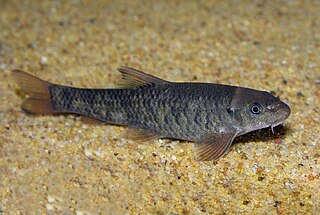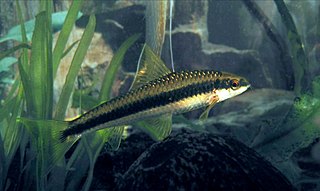
The red garra, also known as the doctor fish or nibble fish, is a species of cyprinid that is native to a wide range of freshwater habitats in subtropical parts of Western Asia. This small fish typically is up to about 14 cm (5.5 in) in total length, but locally individuals can reach as much as 24 cm (9.5 in).

Garra barreimiae, the Oman garra, is a species of ray-finned fish in the family Cyprinidae. It is found in the mountains of northern Oman and in the United Arab Emirates. Most populations inhabit wadis, streams, pools and springs, but one population which lives in a cave system, is known as Omani blind cave fish, and has lost its sight and pigmentation. The only other cave fish in the Arabian Peninsula is the Tawi Atair garra, but it has normal eyes.

Garra is a genus of fish in the family Cyprinidae. These fish are one example of the "log suckers", sucker-mouthed barbs and other cyprinids commonly kept in aquaria to keep down algae. The doctor fish of Anatolia and the Middle East belongs in this genus. The majority of the more than 140 species of garras are native to Asia, but about one-fifth of the species are from Africa.
Garra typhlops, also known as the Iran cave barb is a species of ray-finned fish in the family Cyprinidae. It is endemic to caves in Iran. Like other cave-adapted fish, it is blind and lacks pigmentation.
Eidinemacheilus smithi, also known as the Zagroz blind loach, is a species of loach in the family Nemacheilidae. This cavefish is endemic to an aquifer in the Karun River drainage in the Zagros Mountains of Iran.
Typhlogarra widdowsoni or Garra widdowsoni, the Iraq blind barb or Haditha cave garra, is a species of cyprinid fish endemic to underground water systems near Haditha in Iraq. Although traditionally placed in its own genus Typhlogarra, this is not supported by genetic evidence, leading to its move to Garra. This cavefish is considered critically endangered because of water extraction, which has lowered the groundwater level. Once abundant, a survey in 2012 found that it now was very rare. Another species from the same place, Caecocypris basimi, may already be extinct. The only other known cavefish in Iraq is Eidinemacheilus proudlovei.

Labeoninae is a doubtfully distinct subfamily of ray-finned fishes in the family Cyprinidae of order Cypriniformes. They inhabit fresh water and the largest species richness is in the region around southern China, but there are also species elsewhere in Asia, and some members of Garra and Labeo are from Africa. They are a generally very apomorphic group, perhaps the most "advanced" of the Cyprinidae. A common name for these fishes is labeonins or labeoins.
Psilorhynchus arunachalensis is a species of torrent minnow. It is a freshwater benthopelagic fish and which is found in Arunachal Pradesh.
Garra dembeensis, the Dembea stone lapper, is a small African species of ray-finned fish in the family Cyprinidae. It occurs in fast-flowing sections of rivers and wave-washed shores of lakes in the Nile system and other freshwater systems in East and Central Africa, although its presence in the Congo River basin is uncertain.
Garra hughi is an endangered species of ray-finned fish in the genus Garra. It occurs in high mountain streams of the Southern Western Ghats, from the Anamalai Hills, south to the Agasthyamala Hills. The species is a benthopelagic fish, found in mountain streams.
Garra elegans, previously Hemigrammocapoeta elegans, is a species of cyprinid fish. It is a benthopelagic freshwater species endemic to the Euphrates – Tigris basin in Western Asia.
Garra magnidiscus is a species of cyprinid fish in the genus Garra. Identified in 2013, Garra m. is found in the Upper Siang district of Arunachal Pradesh where is it is known locally as Ngop. The name magnidiscus refers to a distinctive large adhesive disc found in the posterior region of its mouth.
Garra elongata is a species of ray-finned fish in the genus Garra from Manipur in north eastern India and possibly Myanamar.
Garra tashanensis is a species of ray-finned fish in the genus Garra. This cavefish is endemic to the Tashan Cave located in the Tashan region of Khuzestan Province, Iran.
Garra lorestanensis is a species of ray-finned fish in the genus Garra Known from the Loven Cave, the natural outlet of a subterranean limestone system of the Zagros Mountains in the Ab-e Sirum or Ab-e Serum Valley near Tang-e Haft railway station, the Tigris River drainage, the Persian Gulf Basin, Lorestan Province, southwestern Iran.
Garra abhoyai is a fish species in the genus Garra endemic to the Chindwin basin in India.
Garra amirhosseini is a fish species in the genus Garra endemic to the Tigris River drainage in Iran.
Garra emarginata is a species of ray-finned fish in the genus Garra endemic to the Periyar River in India.


